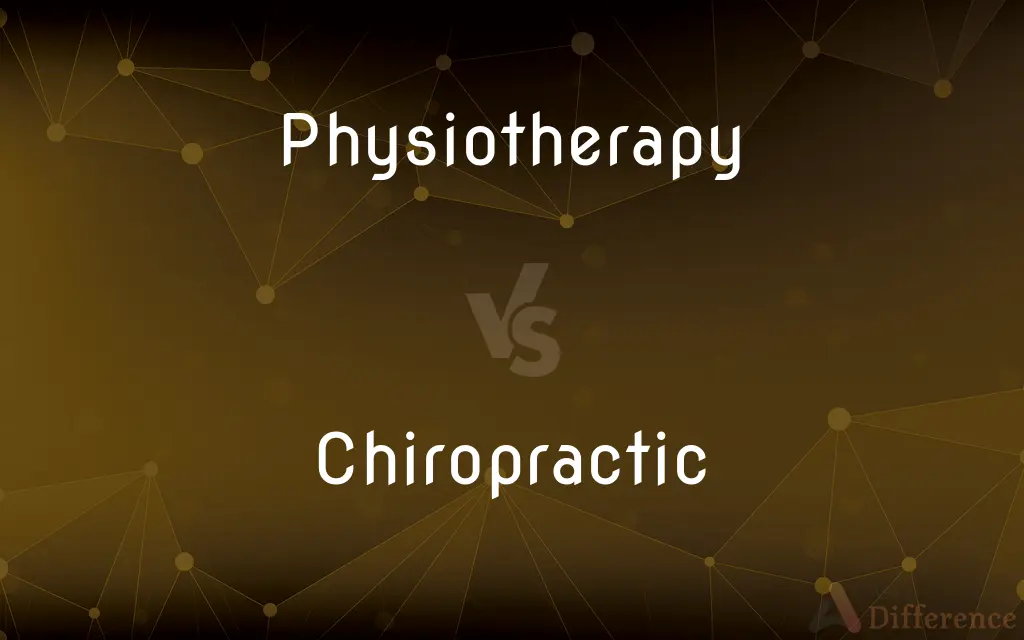Physiotherapy vs. Chiropractic — What's the Difference?
Edited by Tayyaba Rehman — By Urooj Arif — Published on March 5, 2024
Physiotherapy focuses on improving patient mobility and quality of life through exercise and therapy. Chiropractic care emphasizes the diagnosis and treatment of mechanical disorders, particularly those of the spine, through adjustments and manipulations.

Difference Between Physiotherapy and Chiropractic
Table of Contents
ADVERTISEMENT
Key Differences
Physiotherapy and chiropractic care serve distinct yet complementary roles in the healthcare domain. Physiotherapy, a broad field, aims to rehabilitate and improve an individual's physical functions through a tailored mix of exercises, manual therapy techniques, and the use of modalities like ultrasound or electrical stimulation. It addresses a wide range of conditions from sports injuries to post-operative care.
Chiropractic care, on the other hand, primarily focuses on the alignment of the spine and musculoskeletal system, using spinal adjustments and manipulations to relieve pain, improve function, and support the body's natural ability to heal itself.
A key difference lies in their approach and scope of practice. Physiotherapists employ a holistic approach, assessing and treating multiple body parts and systems to enhance movement and overall health. Their interventions often include patient education on lifestyle and ergonomics. Chiropractors specialize in precise interventions, particularly spinal manipulations, to correct alignment issues, believing that proper spinal alignment is central to the body's health and well-being.
The educational pathways for practitioners in both fields also differ, with physiotherapy programs focusing on a broad understanding of the human body, movement science, and rehabilitation techniques, while chiropractic programs concentrate on anatomy, physiology, and specific adjustment techniques. Both require extensive study, clinical practice, and continuing education to maintain licensure and certification.
Physiotherapy treatments are typically part of a longer-term rehabilitation plan, incorporating home exercises and ongoing assessment. Chiropractic sessions may provide quicker relief for certain conditions through adjustments, but may also recommend a series of visits for maintenance or ongoing care.
ADVERTISEMENT
Patients might choose physiotherapy for rehabilitation from injury, management of chronic conditions, or to improve mobility and function across various systems of the body. Chiropractic care is often sought for acute back pain, neck pain, headaches, and conditions related to spinal alignment. Many find combining both approaches beneficial for comprehensive musculoskeletal care.
Comparison Chart
Focus
Rehabilitation, improving movement
Spinal alignment, mechanical disorders
Techniques
Exercises, manual therapy, modalities
Spinal adjustments, manipulations
Approach
Holistic, addressing various conditions
Specific, centered on spinal health
Educational Background
Broad study of human movement and rehabilitation
Deep focus on anatomy, spinal health, and adjustments
Treatment Duration
Long-term with home exercises
Short-term relief but may recommend ongoing visits
Compare with Definitions
Physiotherapy
Uses exercises and manual therapies.
The physiotherapist prescribed exercises and performed manual therapy for her knee pain.
Chiropractic
Focuses on diagnosing and treating spinal disorders.
She visited a chiropractor for her chronic neck pain.
Physiotherapy
Aims at rehabilitation and long-term wellness.
Physiotherapy played a key role in her recovery from a sports injury.
Chiropractic
May offer immediate pain relief.
A single chiropractic session offered her immediate relief from headaches.
Physiotherapy
Treats a wide range of conditions.
Physiotherapy helped him manage his chronic lower back pain effectively.
Chiropractic
Utilizes spinal adjustments for treatment.
The chiropractic adjustment relieved his lower back pain.
Physiotherapy
Offers education on prevention and lifestyle.
Her physiotherapy sessions included advice on ergonomic work setups.
Chiropractic
Believes in spinal health for overall well-being.
Regular chiropractic care supported his overall health maintenance.
Physiotherapy
A healthcare profession focused on enhancing physical function.
After his surgery, he underwent physiotherapy to regain strength.
Chiropractic
Often involves a series of treatments.
His chiropractor recommended a treatment plan for his spinal alignment issues.
Physiotherapy
Therapy that uses physical techniques such as massage, ultrasound, heat, and exercise.
Chiropractic
A system of health care that focuses on disorders of the musculoskeletal system and nervous system and their effects on overall health. The method of treatment usually involves manipulation of the spinal column and other body structures.
Physiotherapy
Therapy that uses physical agents: exercise and massage and other modalities
Chiropractic
(alternative medicine) A system of health care involving manipulation of the spinal column and other body structures, for the purpose of alleviating neuromusculoskeletal dysfunction.
Chiropractic
Relating to chiropractics.
Chiropractic
A method of medical treatment that manipulates body structures, especially the spine, in the belief that it restores proper nerve functioning.
Common Curiosities
Can I undergo both physiotherapy and chiropractic care?
Yes, many patients benefit from a multidisciplinary approach, combining both therapies to achieve optimal health outcomes.
How do I choose between physiotherapy and chiropractic care?
Consider the nature of your condition; physiotherapy for a broad range of rehabilitation needs, and chiropractic for issues centered around spinal alignment and related pain.
What qualifications do physiotherapists and chiropractors hold?
Both professionals undergo rigorous university-level training, clinical practice, and must be licensed to practice, with ongoing education to maintain their licensure.
How long does it take to see results from physiotherapy or chiropractic care?
It varies; some may experience immediate relief with chiropractic adjustments, while physiotherapy results may be observed over a longer period with consistent participation.
What's the difference in treatment duration between physiotherapy and chiropractic?
Physiotherapy may involve a longer-term plan with exercises to perform at home, while chiropractic might suggest a series of adjustments over a shorter period for immediate relief.
Is chiropractic care safe?
Yes, when performed by a licensed practitioner, chiropractic care is generally safe and effective for treating certain conditions, particularly those related to the spine.
What conditions can physiotherapy treat?
Musculoskeletal injuries, post-surgical rehabilitation, chronic pain conditions, neurological disorders, and more.
Are these therapies covered by insurance?
Coverage varies by location and insurance plan; many plans cover both physiotherapy and chiropractic care, but it's important to check with your insurance provider.
Can physiotherapy and chiropractic care prevent surgery?
In some cases, these therapies can alleviate pain and improve function to the point that surgery may be delayed or no longer necessary, but this depends on the specific condition and severity.
What's the best way to find a reputable physiotherapist or chiropractor?
Look for licensed professionals with good reviews, ask for recommendations from healthcare providers, and check professional registries or associations.
Share Your Discovery

Previous Comparison
Crocodiles vs. Alligators
Next Comparison
E-Commerce vs. E-BbusinessAuthor Spotlight
Written by
Urooj ArifUrooj is a skilled content writer at Ask Difference, known for her exceptional ability to simplify complex topics into engaging and informative content. With a passion for research and a flair for clear, concise writing, she consistently delivers articles that resonate with our diverse audience.
Edited by
Tayyaba RehmanTayyaba Rehman is a distinguished writer, currently serving as a primary contributor to askdifference.com. As a researcher in semantics and etymology, Tayyaba's passion for the complexity of languages and their distinctions has found a perfect home on the platform. Tayyaba delves into the intricacies of language, distinguishing between commonly confused words and phrases, thereby providing clarity for readers worldwide.
















































